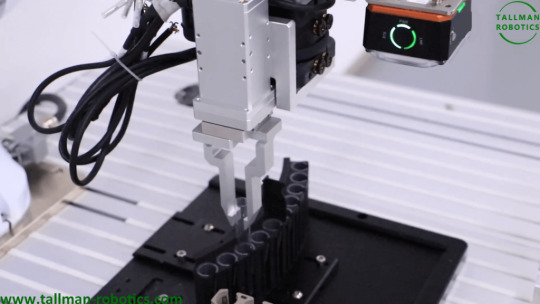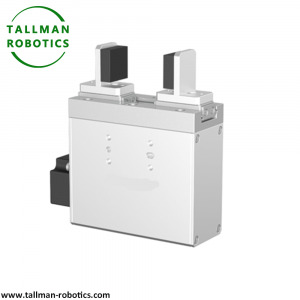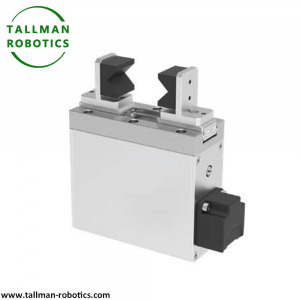#FreelyProgrammableElectricGrippers
Explore tagged Tumblr posts
Text
Servo Motor Electric Grippers are Delivered to Germany


Servo Motor Electric Grippers are finished for Gremany clients. You are welcome to visit our download centre to check E-catalogues or watch our video centre to check more projects. Electric gripper is an important part of robot system, which is mainly used to hold and operate tools or workpieces, and bears important operation and execution functions. Integrated electric gripper,Servo Motor Electric Grippers. ● based on integrated step servo motor ● use gear rack to drive the gripper finger ● the inner wall is used for micro guide rail positioning and clamping finger limit position limit. https://youtube.com/shorts/kt8jFpMKVok?feature=share Obstacles and challenges of intelligent PLC breaking the cocoon into a butterfly PLC is the product of industry in the 3.0 era. After more than 50 years of development, the technology continues to push through the old and bring forth the new, and the product categories continue to be enriched. As the brain that controls the industrial production system, the emergence of PLC has replaced the previous relay that controls high-power equipment, saving manufacturing equipment space, reducing power consumption, and reducing the workload of engineer equipment maintenance. At present, industrial manufacturing is transitioning to 4.0, and manufacturing enterprises need to complete the transformation and upgrading. On the one hand, they need to improve the automation level of manufacturing equipment; on the other hand, they need to integrate Internet technology on the basis of industrial control technology. With the help of consumption data, optimize supply chain management and reasonably plan factory manufacturing production. Therefore, in industrial automation, PLC, as the "brain", plays a very important role in the new round of industrial reform. 1 today's PLC is no longer a traditional PLC In short, PLC is a special computer for industrial control, which uses programmable memory to store instructions, perform functions such as logic, sequence, timing, calculation, and control various mechanical production processes through simulation or mathematical i/o. Among them, CPU is the brain of PLC, which executes user programs, summarizes, analyzes and processes the information collected from other modules. Smart factories have the characteristics of comprehensive perception, optimized decision-making, accurate implementation, and independent business management and manufacturing operations. To realize intelligent manufacturing, multifunctional and high-performance industrial controllers cannot be absent. In previous industrial sites, the same equipment, process section and production line may be multiple controllers, such as the industrial robot platform, which is robot controller +plc, and the flexible processing unit is cnc+plc. The future smart factory needs to control all units by a "brain". Dr. xiaoweirong, President of Greater China of baccalais, once proposed in the online open class that today's PLC is no longer a traditional PLC. He pointed out that when traditional PLC performs multiple tasks, it starts from task by task and starts again. On the basis of multiple tasks in a project, the system is divided into multiple task levels, each task corresponds to a cycle, and priority is set according to the length of the cycle. It can be seen that the new PLC is not simply performing logical tasks, but can handle more complex processes in the production line. In the event of an emergency, the multi task processing function of the new generation of PLC will not be interrupted like the traditional PLC. In other words, the brain of today's industrial production system needs a highly intelligent PLC. Some insiders also pointed out that today's large PLC system itself is a distributed computing system based on Fieldbus and LAN, and the application of relevant technologies supporting cloud mode distributed computing system in the field of industrial control will bring revolutionary changes in the architecture, technical architecture, product form and application mode of industrial control system. In the process of manufacturing turning to "intelligent" manufacturing, there are still many research topics in the field of PLC. 2 what kind of PLC can meet the requirements of industry 4.0? Under the background of industry 4.0, the factory network has moved from closed LAN to external interconnection, so the communication mode of PLC also needs to be changed. PLC communication system can form a more complex control system through PROFINET, CC link, DeviceNet and other networking, but many PLCs do not match with barcode scanners, RFID readers, sensors, industrial cameras and other equipment required by smart factories. The premise of intelligent manufacturing is to collect data. The material management, equipment management and other data of the factory should be integrated into the MES system, so as to provide a stronger hardware foundation for the comprehensive digitalization of enterprise production and manufacturing, logistics warehousing and marketing management. It can be seen that there are many challenges in developing a PLC that meets the requirements of industry 4.0, waiting for researchers to overcome. First, we need to deal with huge production data and increasingly complex algorithms. Under intelligent manufacturing with Servo Motor Electric Grippers , it is inevitable that PLC needs to store more production data. On the one hand, consumer terminals' requirements for product personalization and quality are improving, and factories need to improve production technology and reduce manufacturing costs. Therefore, the bottom control system needs to deal with large-scale production data and logical relationships; On the other hand, in order to process a large number of production data, the algorithm behind the PLC hardware is required to be higher. There is a certain technical threshold for writing a good algorithm. Secondly, the simplicity of the supporting programming software design. As consumers' requirements for products increase, the complexity of factory production will certainly increase. PLC is required to complete PID control, network communication, high-speed calculator, position control, data recording, text display and other functions. This means that the difficulty of programming is increasing. Moreover, the PLC programming languages of different brands in the market are different, and engineers need to master a variety of programming languages. From the perspective of terminal procurement, engineers can learn once and use everywhere to reduce the cost of personnel training, technical consulting, system debugging and software maintenance. It is a practical PLC product. Thirdly, understand the operating habits of engineers in specific downstream application scenarios. In the practical application of PLC, users will encounter the so-called Japanese system and German system, both of which have their own advantages in software programming. Since PLC is a product combining software and hardware, the software of PLC needs to be adjusted accordingly in different application scenarios. In addition, different application scenarios will lead to different operating habits of engineers. Conversely, PLC suppliers are required to reconstruct the general PLC software for specific downstream industries and engineers' operating habits. No matter in any industry or in the new manufacturing environment, the software programming of PLC tends to be simple and easy to operate. 3.Competition pattern of domestic PLC Market China is the largest processing plant in the world, and the use of natural PLC is also huge. In the domestic PLC market, Europe, America and Japan are the main ones. In terms of European and American brands, Siemens, Rockwell and Schneider are represented. Among them, Siemens has excellent performance in small, medium and large products, and has become a major supplier in the domestic PLC market, with a market share of 40.7% in 2016 alone; Rockwell maintains a leading position in the large PLC market, with a share of 10.1%; As an old PLC supplier, Schneider's share has been maintained at about 9%. In Japan, the representative enterprises are Mitsubishi and OMRON. With the advantages of cost performance and market channels, they maintain a high level of competition in China. In addition, Taiwan funded Delta has dug deep into the OEM market with the advantage of high cost performance. At the same time, it adheres to the solution of mutual cooperation between PLC, frequency converter and servo driver, and the market sales have maintained a high-speed growth trend. In terms of local PLC, its development has a history of nearly 40 years, which can be roughly divided into the introduction period from the 1980s to the 1990s. At this time, PLC on the market are all overseas brands. From the 1990s to 200, it is the start-up period of local industrial control enterprises, and local PLC brands began to appear. After 2000, it is the development period of local PLC brands. Local brands start with small PLC with low technical threshold, and have localization advantages to achieve rapid growth. In recent years, the local medium-sized PLC market has made a breakthrough. For example, the AM series medium-sized PLC launched by Huichuan technology has made great breakthroughs in expanding the number of points, communication functions, program capacity, etc; Xinjie Electric is introducing XG series medium-sized PLC, which can support 20 axis servo control and all functions of standard PLC, with faster processing speed. epilogue PLC is an indispensable part of factory automation and industrial process control. In the era of intelligent manufacturing with Servo Motor Electric Grippers , it is inevitable to further improve the performance of PLC, so it needs to be fundamentally redesigned, including high-performance control, interconnection, safe communication, cross platform operation, and timeliness. From a market perspective, PLC has sales channel barriers, and the market of single PLC products in industrial automation enterprises usually has a hidden ceiling. Take foreign high-end brands as an example: first, combine their own advantages to find a suitable entry point; Secondly, after being recognized by customers, gradually improve the product research and development of the industrial chain, from a single supplier to a solution provider; Finally, take advantage of technology precipitation and brand advantages to become a comprehensive supplier across the medium and high-end market. Read the full article
#2-jawparallelself-centeringelectricgrippers#3-jawself-centringparallelelectricgrippers#ElectricGrippers#ElectricServoGripper#FreelyProgrammableElectricGrippers#RoboticGripperwithControllerBuilt-in#ServoMotorElectricGrippers#ServoMotorRobotGrippers#Servo-ElectricGrippers
0 notes
Text
Servo Electric Grippers

Servo Electric Grippers: Designed for gripping hard, soft, shaped and fragile objects. You are welcome to visit our download centre to check E-catalogues or watch our video centre to check more projects.



Technical Parameters about Tallman Robotics Servo Electric Grippers Model No. TM-GB-11-20-1.6 TM-GB-11-40-1.6 TM-GB-17-60-2 Applicable Controller TM-C TM-C TM-C Max Clamping Force (N) 65 110 250 Max clamping speed(mm/s) 100 100 100 Lead (mm) 1.6 1.6 2 Stroke (mm) 20 40 60 Repeatability (mm) ±0.05 ±0.05 ±0.05 Backlash (mm) Less than 0.1 on one side Less than 0.1 on one side Less than 0.1 on one side Allowable Load Torque (N.m) MR:9.0、MP:6.5、MY6.5 MR:9.0、MP:6.5、MY6.5 MR:58.5、MP:25.0、MY25.5 Mass (kg) 0.8 1.1 2.1 Recommended Use Environment (temperature and humidity) 0~40℃, below 85%RH (without condensation) 0~40℃, below 85%RH (without condensation) 0~40℃, below 85%RH (without condensation) https://youtu.be/vmLYDdPPiQc Electric gripper (also called "servo gripper") is an intelligent electric cylinder that is composed of non-standard structural parts, transmission parts, servo motor, PLC control system and control program. Its speed, stroke and clamping force can be separately Independent control. Compared with pneumatic grippers, it has more powerful functions and a wider range of applications. Commonly used in food, medical, laboratory and other precision gas-free environment. Tallman Robotics has developed Servo Electric Grippers, servo pushers, servo slides, servo rotary cylinders and integrated drive and control controllers, and offers servo electric cylinders. Driven by the motor to realize the tightening and releasing of the claw fingers, the positioning point can be controlled, and the clamping force can be controlled; controlled by the host computer such as PLC, industrial PC, single chip computer and motion controller to realize the grasping and positioning of objects And other functions are the flexible execution terminals of the device. Widely used in industrial automation industry: a. Mobile phone, TV, home appliance and other electronic manufacturing enterprises b. Automobile/auto parts manufacturers c. Medical equipment manufacturing enterprises d. Factory automation, complete equipment supplier f. Non-standard automation equipment in various industries g. Industrial robot integration Suitable for the clamping of easily deformed and fragile work pieces in industrial automation; Speed, position, clamping force and other parameters can be controlled; Work piece transfer discharge; Picking and placing materials in narrow spaces; Laboratory, medical and other places where there is no compressed air source and other places where pneumatic grippers are not suitable; To achieve high-speed opening and closing and high clamping force; Available in parallel opening and closing type and lever type; Multi-point positioning and clamping force adjustment are possible; Built-in clamping confirmation and dimensional measurement functions Common robots often have errors such as not being able to get the clips, dropping them up, or damaging the work pieces during the clamping operation in running water. In order to reduce errors, companies will install various sensors on the gripper, which makes the robot huge and bulky. Robust Motion Limited has a "clamp confirmation" function built into the servo gripper, which enables the "automatic identification of the clamping state" without the need for external sensors. In addition, it also has a built-in "clamp measurement" function, which can judge the size of the work piece through tolerance identification. Powerful adaptive gripping function In the face of clamping objects of various shapes, soft and hard, and different sizes, the problems of slow gripping, difficult debugging, and low work efficiency of the traditional air gripper are obvious. If the air gripper is to be held flexibly, the engineer must reduce the air pressure or the gripping speed, so that the gripping time is too long, and the gripped items are easy to fall. SGA-RM servo gripper, while not changing the gripping speed, adds an "adaptive gripping" function, which automatically grips objects of various shapes using an adaptive force. Even when fragile eggs, egg rolls, glass bottles or small heat sinks are gripped, they are as natural as human hands. No drop after power off TM servo gripper also has an intelligent protection mechanism. During the gripping process, the work piece is not dropped due to power failure, which maximizes the protection of the company's production interests. This is something that traditional cylinders cannot do. Read the full article
#All-in-oneServoGrippers#CollaborativeRobotGrippers#ElectricGrippersforIndustrialAutomation#ElectricSmallComponents#FingerParallelGripper#FreelyProgrammableElectricGrippers#IndustrialRobotsElectricGrippers#IntelligentRobotGrippers#ServoElectricGrippers#ServoMotorElectricGripper#SmallPartsGripper#SmartAngularGripper#SmartCompliantRoboticGripper#SmartIndustrialRoboticClaw#Three-fingerElectricGrippers#Three-jawElectricGrippers
0 notes